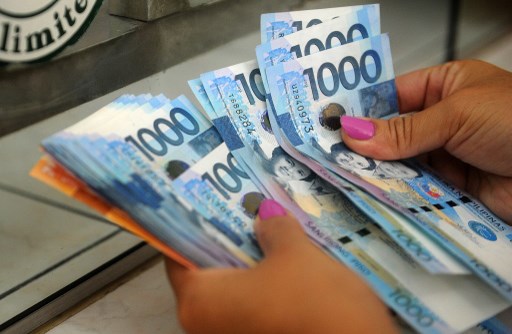Third straight day that peso hit new record lows

(Eagle News) – The Philippine peso sank to a new record low of P58.49 to a US dollar on Thursday, September 22, the third straight day that the peso had gone down to record lows.
On Wednesday, Sept. 21, the peso went down to P58 to a dollar, and the previous day, Tuesday (Sept. 20), it closed at P57.48.
This came about as the US Federal Reserve hiked its interest rates again to rein in soaring prices in the US.
This Fed rate hike led to sharp losses in Asia, Europe and on Wall Street.
In Japan, the yen also sank to a fresh 24-year low against the dollar on Thursday, with the greenback surging to nearly 146. This prompted Japan’s finance ministry to intervene in the currency market to bolster the yen.
The British pound also briefly dived to a new 37-year low at $1.1212, even as the Bank of England prepared to announce its second bumper rate rise in a row later Thursday, according to an Agence France Presse report.
The euro also sank to a 20-year dollar low.
-PHL Monetary Board raises interest rates-
In the Philippines, the Monetary Board decided to raise the interest rate on the Bangko Sentral ng Pilipinas’ overnight reverse repurchase facility by 50 basis points to 4.25 percent, effective tomorrow, September 23.
“The BSP’s latest baseline forecasts show that average inflation is still projected to breach the upper end of the 2-4 percent target range at 5.6 percent in 2022. The forecast for 2023 has also increased slightly to 4.1 percent. Meanwhile, the forecast for 2024 eases to 3.0 percent,” the BSP said on Thursday, Sept. 22.
In deciding to raise the policy rate anew, the Monetary Board noted that price pressures continue to broaden.
In a release, it said that “the rise in core inflation indicates emerging demand-side pressures on inflation.”
“Moreover, second-round effects continue to manifest, with inflation expectations remaining elevated in September following the approved minimum wage and transport fare increases. Nonetheless, inflation expectations continue to be broadly anchored over the medium term,” it said.
This month of September alone, the peso recorded new lows eight times.
On Sept. 2, the peso sank to P56.77 to a US dollar. On Sept. 5, it went down further to P56.99 to a dollar. The following day, Sept. 6, the peso fell to P57:$1. Two days later, on Sept. 8, the peso sank further to P57.18 to the greenback. On Sept. 16, it slid further to P57.43, and on Sept. 20, it dipped to P57.48.
There might be more increases in rates to be made by the US Federal Reserve to protect the US dollar.
-US Federal Reserve expected to continue hike in rates-
US Federal Reserve Chair Jerome Powell warned that the process of conquering the highest inflation in 40 years will involve some pain.
It was the third consecutive increase of 0.75 percentage point by the Fed’s policy-setting Federal Open Market Committee (FOMC), continuing the forceful action that has included five hikes this year.
The increase takes the policy rate to 3.0-3.25 percent, and the FOMC said it anticipates that “ongoing increases… will be appropriate.”
“We have got to get inflation behind us. I wish there were a painless way to do that. There isn’t,” Powell said.
The Federal Reserve signalled more hefty US interest rate hikes.
Soaring prices are putting the squeeze on American families and businesses, and have become a political liability for President Joe Biden as he faces midterm congressional elections in early November.
But a contraction of the world’s largest economy would be a more damaging blow to Biden, and the world at large.
Powell has made it clear officials will continue to act aggressively to cool the economy and avoid a repeat of the 1970s and early 1980s, the last time US inflation got out of control.
It took tough action — and a recession — to finally bring prices down in the 1980s, and the Fed is unwilling to give up its hard-won, inflation-fighting credibility.
The Fed’s quarterly forecasts released with the rate decision Wednesday show FOMC members expect US GDP growth to virtually flatline this year, rising just 0.2 percent. But they see a return to expansion in 2023, with annual growth of 1.2 percent.
They project further rate hikes this year — totaling 1.25 percentage points — and more in 2023, with no cuts until 2024.
Inflation is a global phenomenon amid the Russian war in Ukraine on top of global supply chain snarls and Covid lockdowns in China, and other major central banks are taking action as well.
(With a report from Agence France Presse)







